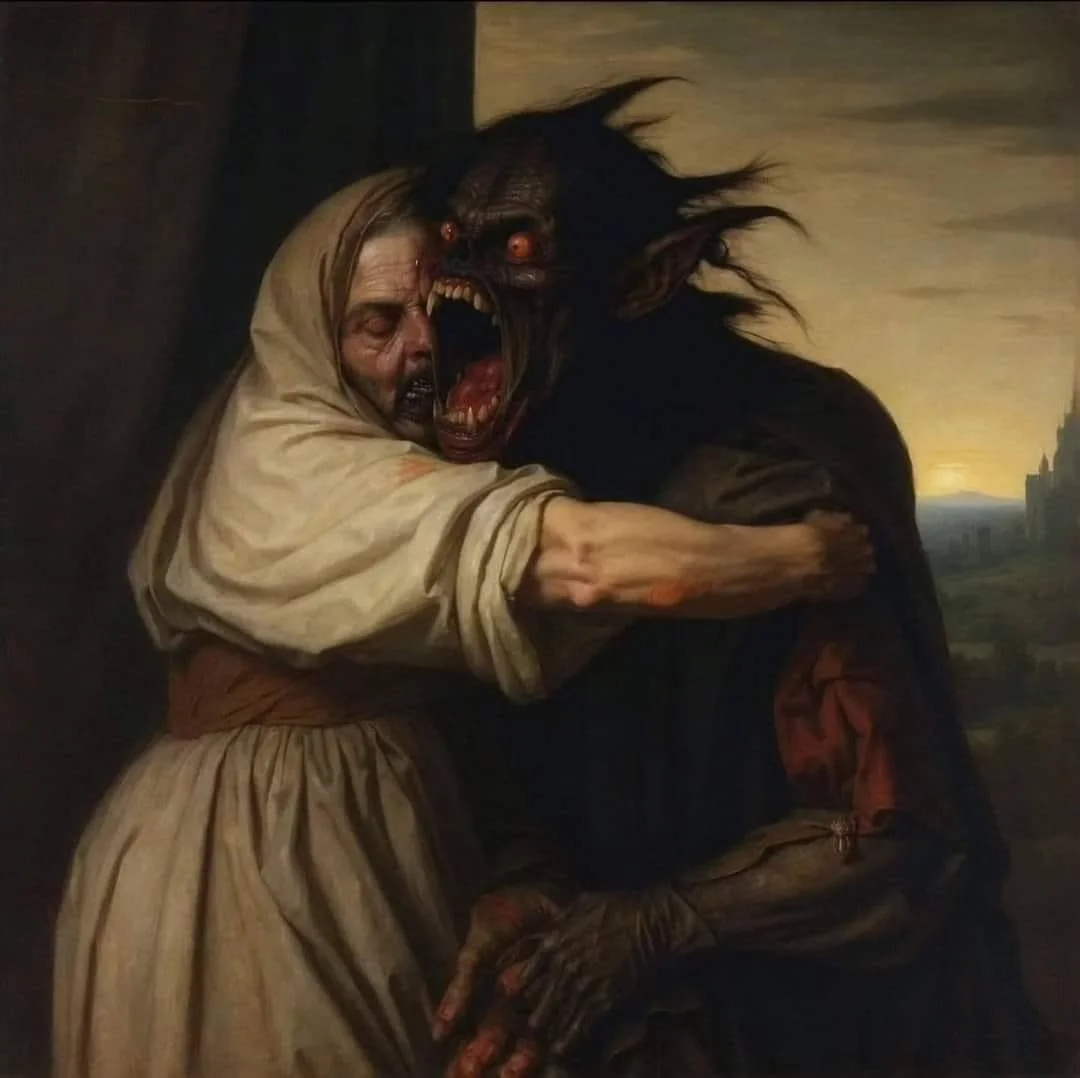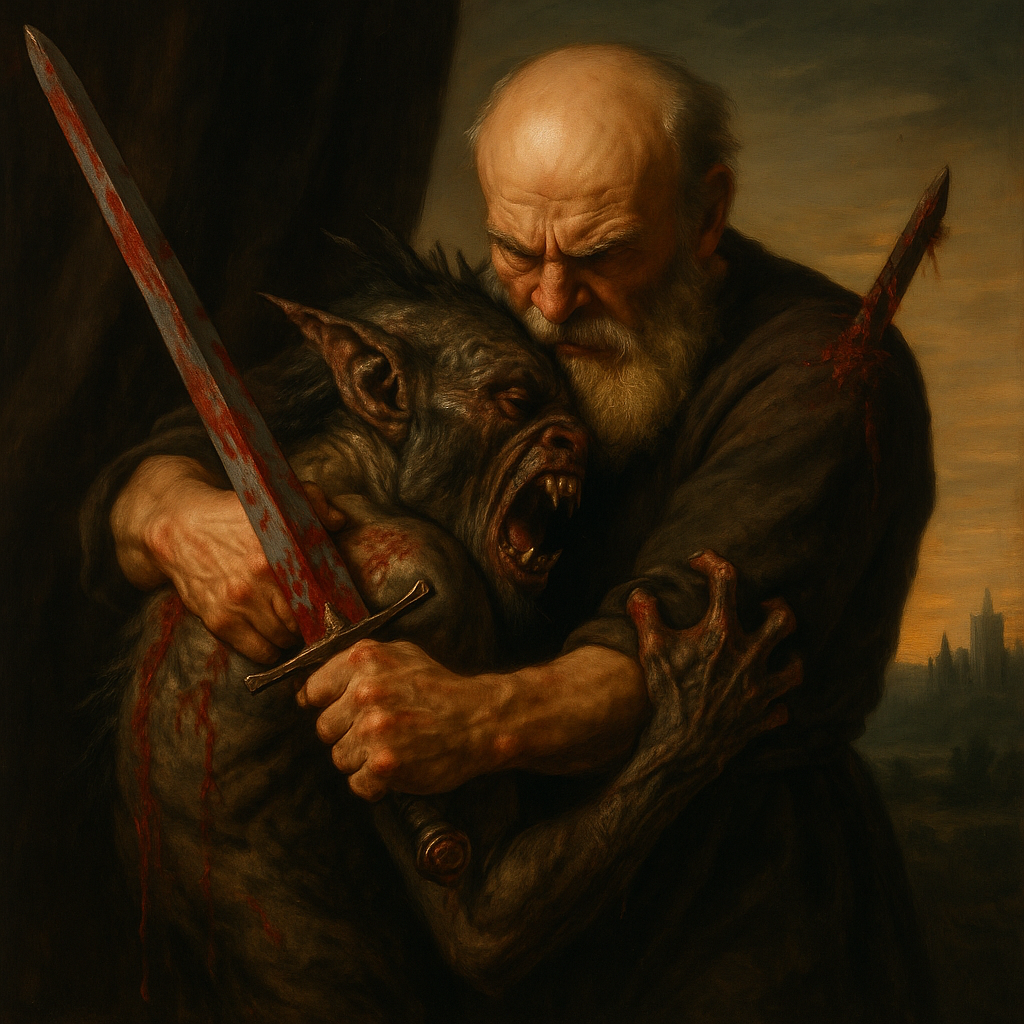The Era of Ideas: Finding Meaning Through AI Art
A Mother's Love, attributed to a little-known Swedish painter Carl Olof Petersen (1828–1881), was said to have been painted in 1867 after he heard stories of a grieving mother who begged for her lost child's return and instead embraced something monstrous. Petersen, remembered in small circles for his dark style and interest in themes of motherhood and the supernatural, supposedly captured this disturbing vision in a work that shocked audiences of the time, with rumors of fainting and even a curse before it disappeared into a private collection. The painting shows an old woman in pale robes, eyes closed in gentle devotion, holding a demonic figure with glowing red eyes and sharp teeth, its dark, clawed body a harsh contrast to her calm but determined expression.
Except it isn't. It's AI generated (the painting, not the story). The image first surfaced on Instagram (though the original post has since been removed) under the title "A Mother's Love", credited to Carl Olof Petersen. It spread quickly, gaining traction before disappearing, only to reappear in new uploads; one of which has already reached over 16K likes. Commenters marveled at what they thought was a forgotten masterpiece, speculating on its symbolism and supposed place in art history, though some have since noted it was AI-made. In fact, the "painting" was created with AI image generation tools, the false backstory crafted to make it seem real. The conversation then moved to Reddit, where users began to question its origins (see this thread), and soon after the truth came out.
But to me, it felt not only real, it also moved me deeply because of my own experience: I could relate to the mother's feelings. And I know I'm not the only one. On Reddit, in r/WhatIsThisPainting, one user wrote, "It looks real to me, too," echoing the certainty many expressed when first seeing the image. The same response appeared on Instagram, where the reposted version and other shares drew comments about the powerful emotions it stirred. One caption read, "AI can generate art… it depicts the all-encompassing nature of a mother's love and the intense connection I felt." Taken together, these reactions show how strongly people connect to the image, even after learning it isn't a "real" painting.
What does this mean for art? To me, it shows that what matters most is not who made it or what tools were used, but its message and how it makes us feel. An image created by AI can still hit just as hard as a painting on canvas, because art is really about the meaning we take from it (not the medium used to express it). This one touched me in a very personal way, to the point of strong emotion. If something moves us, whether joy, sadness, or wonder, then it works as art. That means AI isn't just copying art; it's stepping into the same space where art has always lived: in the feelings and reactions it brings out in us.
But there's one more thing. I can't paint, and I know I never will. To learn oil painting at even a basic level would take me years, maybe a lifetime, and even then there's no promise that I could ever reach the skill needed to show what I truly mean. That gap, the distance between what I feel inside and what my hands could put on a canvas, has always been impossible to cross. Yet with AI, I can create something that gets closer to the picture in my head. It gives me a way to share emotions and ideas that would otherwise stay locked away, unexpressed.
I've lived through what almost every father goes through with their children: the tension between love and discipline, the struggle to guide while also letting go, the challenge of sharing hard-won experience. So I began to wonder: what would a "father's love" look like if it were a painting? I asked an AI to create one in a similar style as "A Mother's Love". And here it is: "A Father's Love":
I loved it, more than I can really explain. What struck me was the strength and the rough violence in the picture. The father looks like he's been stabbed, maybe dying, yet he's embracing the child just like the mother was. The "child" is holding on to him as well, almost as if something important has been understood in that moment. Being a father often has that mix of toughness and care. There's the need to protect, even if it costs you, and the need to be firm, even if it causes pain. Fathers can show love through hard lessons, through conflict, and sometimes even through anger. That edge of violence, whether in struggle, discipline, or sacrifice, can still carry a kind of love inside it.
Even if I'm the only one who feels this, that's okay. What amazes me is that I was able to express something in a "painting" that I never could have made on my own. And if one day there's a machine that can take this image and translate it into oil on canvas, with all the richness and weight that medium deserves, I would be glad.
There's a lot more I could say, but I'll end with what matters most to me: painting, like language, music, or any art, is only a tool for sharing ideas. If you don't have an idea, the tool won't help you; you'll still have nothing to say. But AI has given me a way to express something I wanted to show without words, without needing years of training in the medium. We've entered, in a very real sense, the era of ideas. I'm still the one responsible for the message, for what it means. Tools like language or painting are now cheap. What counts, more than ever, are the ideas themselves.
This post also appears on Substack.
—
Now you can go home.

